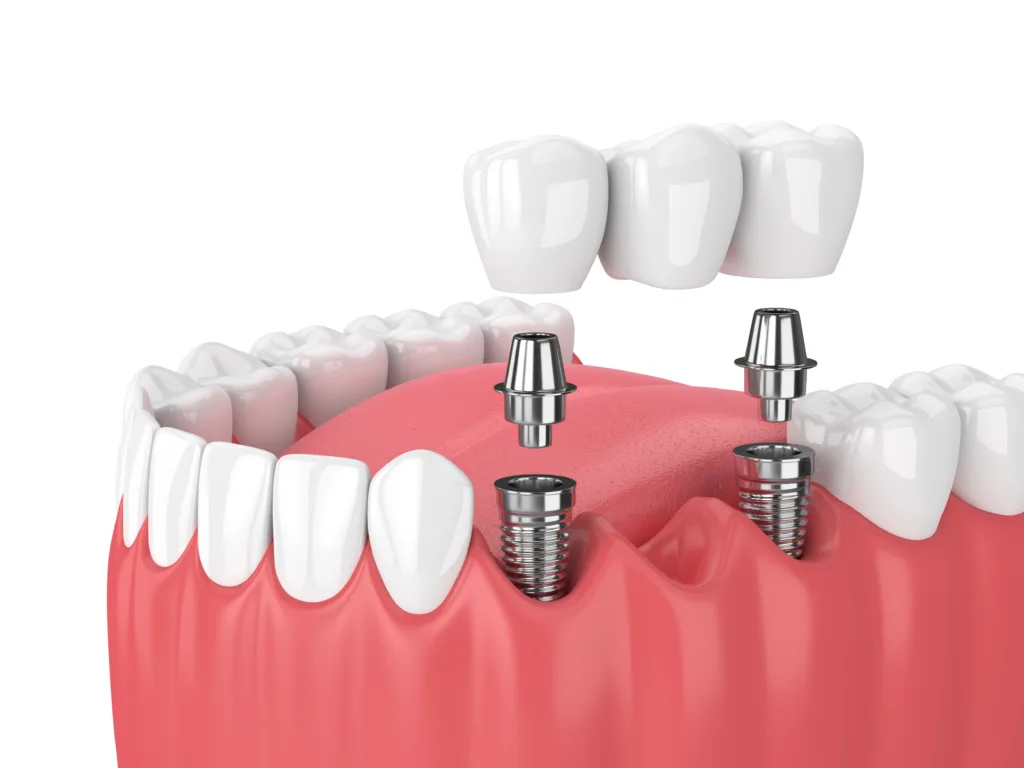
There are lots of possible reasons you may have missing teeth, from decay and gum disease to injury and aging. No matter why your smile is incomplete, it’s important to replace missing teeth to protect your oral health, restore proper function, and improve your smile’s appearance.
At Smile Solutions Dentistry, we offer multiple restorative options for patients with missing teeth, including implants, implant-supported dentures, full and partial dentures, and bridges. If you’re wondering which of these solutions may be right for you, keep reading to learn more about each option to help you make an informed decision.
Why Replacing Missing Teeth Matters
First, let’s take a look at why replacing missing teeth matters. If you’ve lived for a while without all your teeth, you may be wondering whether it’s worth it to restore your smile. What you may not realize is that missing teeth can have a serious impact on your oral health and affect your daily life.
Your jawbone requires stimulation to stay strong and healthy. When you’re missing a tooth, the jaw doesn’t get the stimulation it needs, leading to bone loss over time. This can cause the remaining teeth to shift out of place, causing issues with your bite or even changing your facial structure.
Furthermore, gaps in the gum line can make it easier for food particles and bacteria to accumulate. With bacteria comes gum disease, plaque buildup, and tooth decay, putting your oral health at risk.
Finally, missing teeth can impact everyday activities like chewing and speaking. Plus, gaps in your smile can affect your self-confidence, making it hard to express yourself the way you want to.
Dental Implants: A Long-Lasting Solution
Dental implants are a permanent, durable solution for missing tooth replacement. Consisting of a metal post implanted into the jaw that supports a prosthesis, they can be used to replace a single tooth or an entire arch.
The types of dental implants include:
- Single-tooth implants: These implants replace a single tooth, making them ideal for patients whose teeth are mostly intact.
- Multi-tooth implants: These implants are designed to replace multiple teeth in a row.
- All-on-4 implants: These implants replace an entire arch of missing teeth, whether top or bottom, using just four implants.
The biggest benefit of dental implants is that they look, feel, and function just like natural teeth. They’re specially crafted to mimic the appearance of the surrounding teeth, creating a seamless result. Plus, the implants provide jawbone stimulation, helping to preserve bone structure.

Implant-Supported Dentures: Enhanced Stability
Implant-supported dentures are just what they sound like — essentially, they’re traditional dentures that are secured using implants. They’re ideal for patients missing several teeth in a row or an entire arch, giving them more stability, comfort, and chewing ability than traditional dentures.
As you can see, implant-supported dentures are similar to all-on-4 implants. Both use implants to replace an entire arch of teeth; however, they have a few key differences. Implant-supported dentures are removable and can be taken out for cleaning. They may also require more than four implants.
Traditional Dentures
Traditional dentures are another good option for certain patients missing all the teeth in one or both arches, especially those who lack the jawbone stability for implants. Rather than being affixed with implanted posts, traditional dentures utilize temporary adhesive paste to stay in place.
While traditional dentures are not as stable as other options for replacing missing teeth, they can still restore a large degree of function and allow you to smile with confidence. Plus, they’re typically more affordable than implants and provide quicker results, since they don’t require surgery.
Dental Bridges: Bridging the Gap
Dental bridges consist of a replacement tooth (or teeth) supported by the adjacent teeth. They’re best for patients with one or two missing teeth.
There are four types of bridges:
- Traditional bridges are attached to crowns on the adjacent teeth, bridging the gap left by missing teeth.
- Maryland bridges use a metal or porcelain framework, rather than crowns, to secure the replacement tooth.
- Implant-supported bridges are anchored by dental implants, making them the most stable and secure option.
- Cantilever bridges only require one adjacent natural tooth to anchor the false tooth.

Choosing the Right Solution for You
If you’re struggling with missing teeth, it’s important to schedule a personalized consultation with a reputable dentist. They can take into account the number and location of your missing teeth, your jawbone health, your budget, and your lifestyle to ensure you choose the best option for your needs.
Comprehensive Care at Smile Solutions
At Smile Solutions Dentistry, we’re committed to restoring healthy, confident smiles and helping you put the stress of missing teeth behind you. With our wide range of modern solutions, you can finally achieve the radiant smile you’ve always wanted. Contact us today to schedule a consultation and learn more about how we can help.


Follow Us